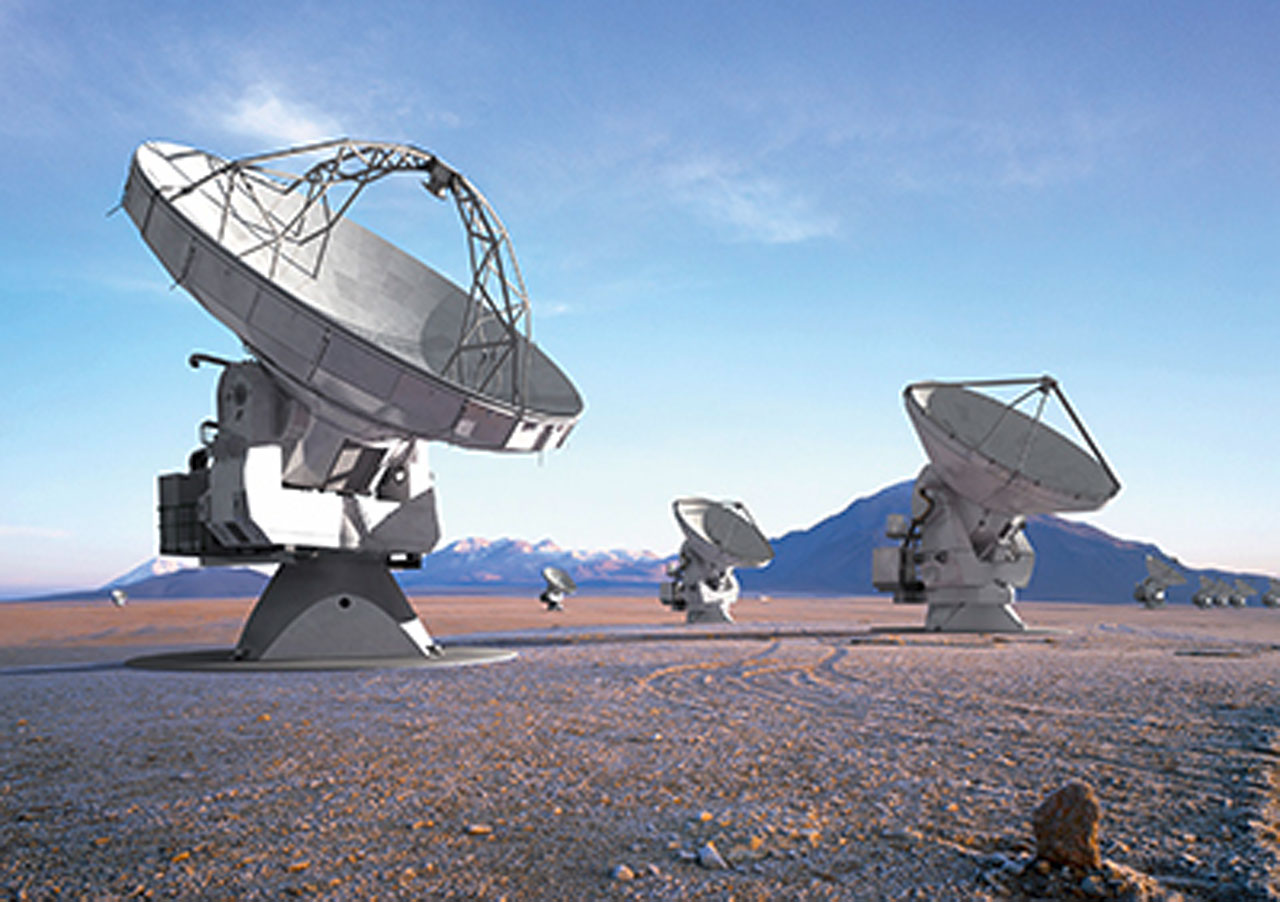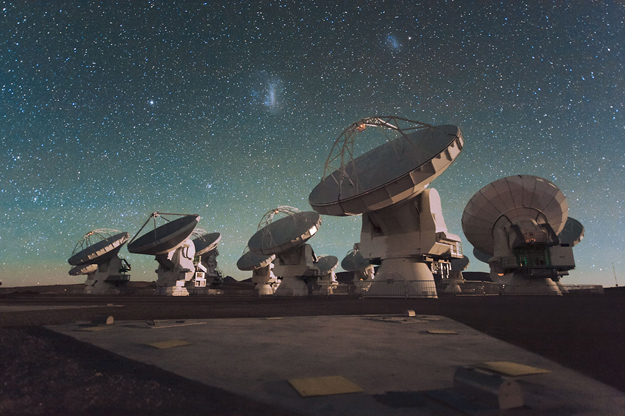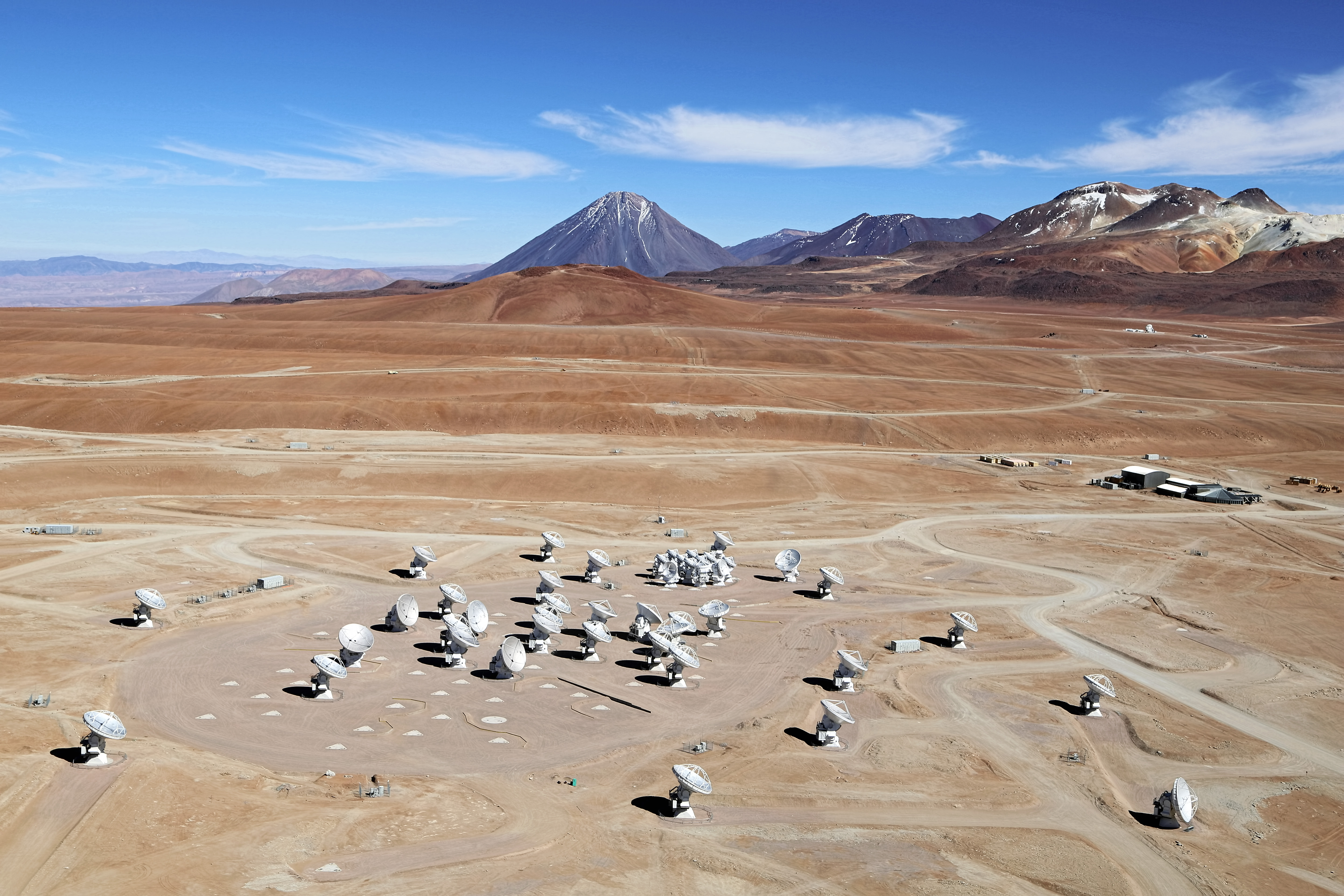Atacama Large Millimeter Array
The Atacama Large Millimeter / submillimeter Array ( ALMA) is the largest radio telescope in the world. It was officially put into operation on March 13, 2013, scientific observations take place, however since October 2011.
After its completion in the course of 2013 ALMA will consist of 66 antennas, 54 meters in diameter with 12 and 12 with 7 meters in diameter, which are used as an interferometer for millimeter-wave and submillimeter waves. Since a high altitude and dry environment is imperative for observations at these wavelengths, ALMA is at about 5000 m above sea level on the Chajnantor plateau in the Atacama Desert in the north Chilean Andes.
ALMA will provide, among other valuable information about the birth of stars, as well as detailed images of the formation of stars and planets, is an international collaboration between Europe, the U.S., Canada, East Asia and the Republic of Chile. At a cost of over one billion U.S. dollars, it is currently the most expensive and largest project of ground-based astronomy.
Survey
ALMA will consist of 66 high-precision antennas and observed at wavelengths from 0.3 to 9.6 mm. The interferometer has a significantly higher sensitivity and resolution than any other submillimeter telescopes. The high sensitivity is achieved by the large number of individual telescopes, which form the interferometer.
The antennas can be moved across the Chajnantor plateau and are thereby positioned at intervals of 150 m to 16 km. This allows ALMA to use as a variable " zoom telescope ", similar to the Very Large Array (VLA ) in New Mexico, USA. Moves to the antennas with the two transporters "Otto" and "Lore ", which to within a few millimeters to position 50 of the 12 - m antennas of the main array and can park on concrete bases.
Manufacturer of antennas are European, North American and East Asian partners in the project. The Americans and Europeans each provide 25 of the 12 - m antennas, which are the main array. East Asia provides a total of 16 antennas ( four 12 - m antennas and 12 antennas with 7 m diameter). These form a small interferometer Atacama compact array (ACA), a part of ALMA interferometer.
Due to the smaller 7-meter antennas at the same frequency can observe a larger area than the main array of the ACA. Since they are closer together, images of objects can be made of a larger size. Along with the main array, the possibility of ALMA is extended to observe large fields of view.
ALMA receivers operate in the frequency bands 30-950 GHz. Due to the high altitude and low humidity at the location where the Earth's atmosphere is sufficiently permeable to these frequencies.
The tasks of ALMA includes the study of the formation regions of planets and stars in cold interstellar clouds and protoplanetary accretion disks. Millimeter waves are particularly well suited to penetrate extensive gas and dust clouds that cover the areas of formation of stars and planets. Infrared galaxies in the early universe, supermassive black holes and galaxy formation are other important research areas of ALMA. In addition, ALMA will help to answer important questions in the study of dark matter and dark energy.
At the site of ALMA more Submillimeterteleskope, including the Atacama Pathfinder Experiment work. In the coming years there is also the Cerro Chajnantor Atacama Telescope, a large single telescope ( 25 m diameter) for the subsequent shorter submillimeter range from 0.03 to 3 mm wavelength, are built.
History
ALMA has its beginnings in three astronomical projects: the Millimeter Array (MMA ) in the USA, the European Large Southern Array ( LSA) and the Japanese Large Millimeter Array ( LMA).
The first step on the road to ALMA was done in 1997, when the U.S. National Radio Astronomy Observatory ( NRAO ) and the European Southern Observatory ( ESO) initiated a joint project, the MMA and LSA should combine. The combined interferometer should combine the sensitivity of the LSA with the wide frequency range of the MMA. ESO and NRAO worked together in scientific, technical and organizational groups to define a project between the two organizations, with participation from Canada and Spain and organize.
Finally, on 25 February 2003 signed the North American and European partners ALMA agreement. On 14 September 2004 ALMA and the National Astronomical Observatory of Japan ( NAOJ ) signed an agreement with Japan was another official partner of ALMA. Under this agreement, Japan should provide the ACA and receivers for three additional frequency bands.
For political reasons, it was decided that three different types of antennas should be designed and built by North American, European and East Asian partners. Although different approaches have been chosen to meet all three types of antennas the strict requirements of ALMA.
Today ALMA consists of a partnership between Europe, North America and East Asia. The work is funded by the ESO, the National Science Foundation (NSF ) in the USA, the National Research Council of Canada (NRC ) and the National Science Council ( NSC) in Taiwan. The construction and operation will be headed for Europe by ESO, for North America of the NRAO and NAOJ from East Asia. The Joint ALMA Observatory ( JAO ) combines the management and organization of construction, commissioning and operation of ALMA.
Initial data were collected by ALMA as part of a test operation in October 2009. In early October 2011, the scientific operations began, although ALMA was completed only a third. Already at that time, so ALMA page is one " a lot better than anything else " was. Gone but will only fully operational ALMA " really show its strengths ," said a front place of competent astronomer end of 2012. Operating in 2011 first several Submillimeterteleskope with four bands of 84-116 GHz, 211-275 GHz, 275-373 GHz and 60-720 GHz. The first images were obtained with ALMA published on 3 October 2011. On March 13, 2013 ALMA was officially put into operation, the completion will take place during the year 2013.
First observation results
In the summer of 2011 enough antennas were thoroughly test observations during the operation to capture first images with ALMA. This gave a foretaste of what to expect from the new interferometer after completion.
The observations were directed towards the Antennae Galaxies, two colliding galaxies with dramatically distorted shapes. Although ALMA has not observed the entire range of galaxies, the images are the best results of these galaxies that have ever been made in the submillimeter range. They show clouds of cold, dense dust in which new stars are born - details which can not be observed in the visible range of the light spectrum.
ALMA Regional Center (ARC )
The ALMA Regional Center (ARC ) serves as the contact point between the scientific users of the telescope in the member countries and the JAO. The ARC is further divided into three geographical regions of the project: Europe (led by ESO ), North America ( led by NRAO ), and East Asia ( led by NAOJ ). The European ARC is additionally divided into ARC nodes that are distributed in Europe in Cologne- Bonn, Bologna, Ondřejov, Onsala, Grenoble, Leiden and Manchester.
Main role of the ARC is to assist the scientific community in the preparation of observing proposals to ensure that all monitoring programs effectively reach their academic goals, to maintain a Help Forum, to provide data to the scientists to entertain the ALMA archive and the scientist is at the data processing support.

_by_night_under_the_Magellanic_Clouds.jpg)







